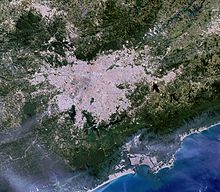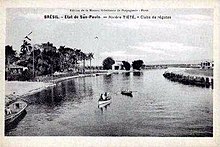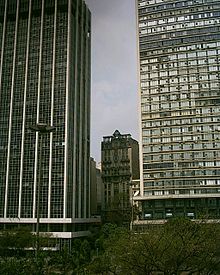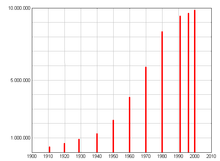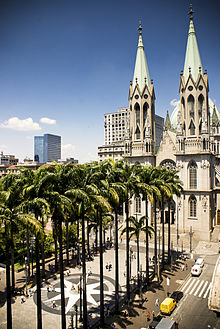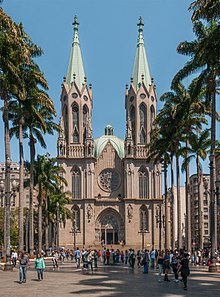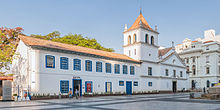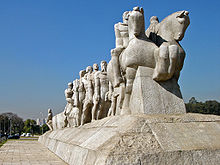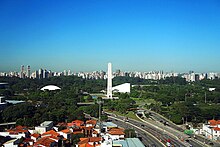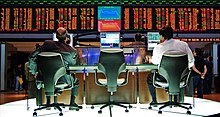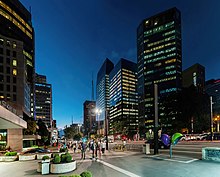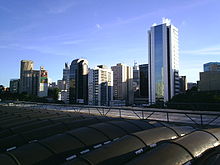São Paulo
| Município de São Paulo
"Terra da garoa"
São Paulo
"Sampa" "Pauliceia" |
|||
|---|---|---|---|
|
Image montage for São Paulo
|
|||
|
|
|||
| Coordinates | 23 ° 30 ′ S , 46 ° 37 ′ W | ||
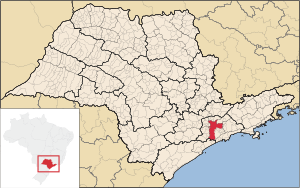 Location of the city of São Paulo in the state of São Paulo Location of the city of São Paulo in the state of São Paulo
|
|||
| Symbols | |||
|
|||
|
Motto "Non ducor duco" "I'm not going out, I run" |
|||
| founding | January 25, 1554 | ||
| Basic data | |||
| Country | Brazil | ||
| State | São Paulo | ||
| ISO 3166-2 | BR-SP | ||
| Região intermediária | São Paulo (since 2017) | ||
| Região imediata | São Paulo (since 2017) | ||
| Mesoregion | Metropolitana de São Paulo (1989-2017) | ||
| Microregion | São Paulo (1989-2017) | ||
| Metropolitan area | São Paulo | ||
| structure | 10 administrative zones, 31 sub-prefectures, 96 districts | ||
| height | 760 m | ||
| Waters | Rio Tietê , Rio Pinheiros | ||
| surface | 1,521.1 km² | ||
| Residents | 11,253,503 (2010) | ||
| density | 7,398.2 Ew. / km² | ||
| estimate | 12,252,023 (July 1, 2019) | ||
| Parish code | IBGE : 3550308 | ||
| Post Code | 01000-000 | ||
| Time zone | UTC −3 | ||
| Website | www.capital.sp.gov.br (Brazilian Portuguese) | ||
| politics | |||
| City Prefect | Bruno Covas (since April 6, 2018) | ||
| Political party | PSDB | ||
| economy | |||
| GDP | 650,544,789 thousand R $ 54,358 R $ per person (2015) |
||
| HDI | 0.805 (2010) | ||
São Paulo [ ˈsɐ̃w ˈpawlu ] ( Portuguese for Saint Paul ) is the capital of the state of the same name and the largest city in Brazil . The city is the most important economic, financial and cultural center in the country as well as an important transport hub.
São Paulo is the largest industrial metropolitan area in Latin America . Around 12.252 million people live in the administrative urban area of São Paulo (2019). As of July 1, 2018, the Grande São Paulo metropolitan region had an estimated 21,571,281 inhabitants, making it one of the largest cities in the world and the second most populous city in the southern hemisphere .
The city is multicultural with numerous immigrants from all over the world , with significant Portuguese , Italian , German , Lebanese and Japanese influences. The inhabitants of the city of São Paulo are called "paulistanos". While “paulista” actually refers to the residents of the state, this term is often used in general terms for the residents of the metropolis.
geography
Geographical location
The city is located in southeast Brazil 80 kilometers from the Atlantic Ocean in the high basin of the Rio Tietê and Rio Pinheiros , an average of 795 meters above sea level . The urban area has an area of 1523 square kilometers and extends approximately 60 kilometers in north-south direction and 80 kilometers in east-west direction.
In addition to the city of São Paulo as a core zone, the Grande São Paulo metropolitan region comprises 38 other cities with a total area of 7947 square kilometers. The built-up urban area of the region with an area of 2209 square kilometers increased by 874 square kilometers from 1962 to 2002.
Twenty kilometers behind the port city of Santos , the Serra do Mar , located in the Brazilian mountains , rises quickly to an average of 1200 meters and then drops to the São Paulo plateau. Santos and São Paulo are connected by a natural pass over the Serra do Mar. The plateau of São Paulo is not flat, but a hilly country, so that the city of São Paulo extends over numerous hills.
Only about half of the water in the Rio Tietê is of natural origin, and the reservoirs in the south of São Paulo, which are important for the urban water supply, can hardly be used for the production of drinking water due to the discharge of untreated wastewater from unplanned housing developments and favelas . The consequences are odor nuisance of the population, eutrophication and an unacceptable taste of the tap water as well as high costs for the achievement of drinking water quality.
geology
The eastern hill country in which the city of São Paulo is located extends from northern Bahia through the states of Minas Gerais , Espírito Santo and São Paulo to the southern part of the state of Paraná . The great differences in altitude and the narrow alternation of towering mountain clods and deeply sunk valleys and basins produce a great variety. In general, the rocks of the ancient Brazilian mass come to the surface, i.e. crystalline schists , acidic and basic plutonites and quartzites .
Inland, the old hull surface flattens out and the overlying layers have been preserved. Among them are the permocarbonic conglomerates in the south, which contain the solidified moraine deposits known as tillites . The gold and diamond deposits, which are so important for the history of the country, can be found in ancient Paleozoic rock series. In terms of landscape, devonian sandstones in the southern part and Cretaceous sandstones in the northern part emerge mainly through their layers . The steep slopes of these strata, directed to the east, often limit the eastern mountainous region.
City structure
São Paulo is divided into 9 administrative zones ( zonas ) according to cardinal points : Northeast, Northwest, West, Center-South, Center, Southeast, South, East 01 and East 02. They are divided into 32 subprefectures ( subprefeituras ) or a total of 96 districts ( distritos ) structured; the latter are divided into districts ( bairros ).
The sub-prefectures of the city are:
Aricanduva / Vila Formosa, Butantã , Campo Limpo, Capela do Socorro, Casa Verde, Cidade Ademar, Cidade Tiradentes, Ermelino Matarazzo, Freguesia do Ó, Guaianazes, Ipiranga , Itaim Paulista, Itaquera, Jabaquara, Jaçanã / Tremembé, Lap'Boi Mirim, Mooca, Parelheiros, Penha, Perus, Pinheiros, Pirituba / Jaraguá, Santana / Tucuruvi, Santo Amaro, São Mateus, São Miguel Paulista, Sé, Vila Maria / Vila Guilherme, Vila Mariana and Vila Prudente.
climate
São Paulo is located in the subtropical climatic zone . Temperatures in summer reach values of 25 to 28 degrees Celsius with peaks of over 30 degrees Celsius, while in winter they rarely drop below 10 degrees Celsius. Frost almost never occurs even in winter. The highest temperature was officially measured on November 15, 1985 with 35.3 degrees Celsius, the lowest on August 2, 1955 with -2.1 degrees Celsius (both at the national weather station "Mirante de Santana" in the northern region). In the surrounding mountains (Horto Florestal) the thermometer sank to −3.9 degrees Celsius on August 2, 1955 (measurement unofficial).
In the history of the city, snowfall is only reported on June 25, 1918. Precipitation is abundant, especially in the warmer months, but is rare between June and August. Neither São Paulo nor the nearby coast has ever been hit by a tropical cyclone , and tornadoes are rare. The winter month of August was mostly dry and comparatively warm in the first years of the 21st century. The temperatures rose to 24 degrees Celsius. This phenomenon is called “Veranico” in Portuguese (“little summer”).
The annual average temperature in São Paulo is 18.5 degrees Celsius, the annual rainfall is 1455 millimeters on average. The warmest months are January and February with an average of 21.0 to 21.3 degrees Celsius, the coldest month is July with an average of 14.7 degrees Celsius. Most of the precipitation falls in the months of January and February with an average of 201 to 239 millimeters, the least in July and August with an average of 39 to 44 millimeters.
| São Paulo | ||||||||||||||||||||||||||||||||||||||||||||||||
|---|---|---|---|---|---|---|---|---|---|---|---|---|---|---|---|---|---|---|---|---|---|---|---|---|---|---|---|---|---|---|---|---|---|---|---|---|---|---|---|---|---|---|---|---|---|---|---|---|
| Climate diagram | ||||||||||||||||||||||||||||||||||||||||||||||||
| ||||||||||||||||||||||||||||||||||||||||||||||||
|
Long-term mean temperature and precipitation (1961–1990)
|
|||||||||||||||||||||||||||||||||||||||||||||||||||||||||||||||||||||||||||||||||||||||||||||||||||||||||||||||||||||||||||||||||||||||||||||||||||||||||||||||||||||
environmental issues

The growth of the city, the high density of industry and the concentration of traffic lead to numerous environmental problems in São Paulo. The pollution of air , water pollution, the disturbance due to noise and emissions from transport and disposal problems with waste and wastewater are the most serious problems of São Paulo.
The pollution of the waters of the Rio Tietê and the Rio Pinheiros by industrial and domestic sewage has resulted in these two main rivers in the urban area becoming biologically dead and mere sewers with high concentrations of heavy metals .
In spring 2015 the supply of fresh water to the city was acutely jeopardized after the reserves from the Sistema Cantareira reservoir had fallen to 6% of normal due to the persistent drought.
The sealing of the areas not only severely restricts the opportunities for the population to relax in a few easily accessible parks in the city, but also hinders the runoff of precipitation. In São Paulo, especially during the summer months (December to March), parts of the city are repeatedly flooded, often with a few fatalities.
The supply and disposal varies greatly depending on the social status of a district. From the city area and the upscale residential areas close to the city center of the transition area, the quality of these services and infrastructural facilities decreases rapidly towards the outskirts. The quality of air and water in the metropolitan core area is, however, worse than in numerous peripheral districts. Despite a slight decrease in individual substances, the air pollution is still alarming, caused by industrial operations (especially airborne dust , nitrogen dioxide , sulfur dioxide ) and road traffic ( carbon monoxide ).
Around 90 percent of the poor air quality is caused by road traffic. Due to the basin location of São Paulo with a lack of air exchange and frequent thermal inversions in winter (June to August), respiratory diseases are very common among the population. There is an urban saying that diseases come with the rain. This can be attributed to the fact that the precipitation washes out pollutants from the air and transports them back to the ground.
history
origin
São Paulo was founded on January 25, 1554, the feast of the conversion of the Apostle Paul , by the Padres Manuel da Nobrega and José de Anchieta , two Jesuit missionaries, at their mission base in Piratininga, named after the local river.
For a long time the area remained isolated because the productivity of the sugar cane plantations there was not particularly high; the residents operated subsistence farming . It was not until the 17th century that wheat was grown in the area for export.
The settlement successively became the capital of the São Vicente captaincy (1681) and São Paulo captaincy (1710). From the Portuguese base of São Vicente, located on the coast of central Brazil in the tropic of the Tropic of Capricorn, near today's Santos , the Jesuits had overcome the steep drop of the coastal mountains (Serra do Mar) covered by tropical rainforests and sometimes over 1000 meters high, all in one The first European settlement was established on the highlands in a high basin about 800 meters above sea level.
In 1711, São Paulo was granted town charter due to its strategic location near a pass over the Serra do Mar. On September 7, 1822, Brazil's independence from Portugal was declared in São Paulo. Even so, São Paulo remained relatively insignificant until the 1870s. However, in the 16th and 17th centuries, the Portuguese immigrants, sometimes mixed with the Indian highland population, roamed from São Paulo as bandeirantes ("standard bearers") in large areas in the central part of Brazil. Above all, as slave hunters, they undertook the notorious raids to catch the Indians, who procured the work slaves needed to grow sugar cane for the owners of the plantations in the coastal lowlands.
Coffee cultivation and industrialization
The economic importance of São Paulo changed rapidly when the cultivation of coffee , which reached the city around 1850 via the Rio Paraíba Valley, increased in the highlands of São Paulo under favorable climate and soil conditions and increasing purchasing power in Europe from the 1880s expanded extensively in northern and northwestern directions.
Excellent infrastructural conditions for the coffee boom created the systematic development of inland traffic in the state of São Paulo by means of radial railroad lines driven from São Paulo on the plateaus between the tributaries of the Río Paraná and the favorable traffic situation to the nearby export port of Santos. A targeted immigration policy, which mainly brought Italians into the country, contributed to the fact that despite the liberation of the slaves in 1888, the workers needed on the coffee plantations were available.
Several hundred thousand Europeans, mostly Italians, but also numerous Germans, Japanese and Lebanese immigrated between 1886 and 1905 and hired themselves mainly on the Paulistani coffee plantations. Some of the Germans were also settled in colonies inside the state of São Paulo (Rio Claro, Monte Mor, and others). During this phase, the annual population growth rates were up to 14 percent. All of this gave São Paulo its first fortune. But it wasn't until industrialization at the end of the 19th century that it grew to become the largest metropolis in South America.
Industrial metropolitan area
In the 1920s, São Paulo became the leading industrial region in the country. The city's population exceeded one million in 1934 and doubled by 1950. In the early 1960s, high inflation, along with the political mobilization of workers, peasants and students who began to claim their political rights, led to the military taking power in 1964. Their government, which lasted until 1985, was marked on the one hand by intolerance towards the political opposition , but on the other hand by modernization and economic development, with annual growth rates of around twelve percent in the early 1970s.
Work began on building a new infrastructure and introducing national health and social care. The nearby port city of Santos (fast transport routes), the granting of state loans and the industrial boom, which was reinforced by extensive foreign, especially German investments, helped São Paulo to regain new wealth.
This economic development, based on high foreign debt, took place without the political participation of the population and without a fair distribution of wealth. The result of this change was that a numerically small class had very high purchasing power and, with their influence in politics and economics, strengthened the elitist and authoritarian structures in society. The lack of democratic control of the state at that time led to major deficiencies, low wages and corruption in the quality and distribution of state social benefits, in educational institutions, in public housing, in transport and in sanitary facilities.
At this time, São Paulo was also the founding site of the PT Workers' Party (1980) and the very active trade union umbrella organization CUT (1983). Its emergence and its rapid growth are the result of the powerful strikes and workers' demonstrations that shook Brazil in the late 1970s and early 1980s. These battles shook the military dictatorship and formed the beginning of a development that ended a few years later.
Today the region around São Paulo is the largest industrial metropolitan area in Latin America and the most important industrial location in the third world. The approximately 1000 German companies in the greater São Paulo area form the world's largest concentration of German industrial companies. However, due to globalization , increased exchange rates and the emerging industry throughout the country, São Paulo is becoming less and less important. Industry is increasingly being replaced by the service sector. However, this sector cannot absorb the unemployed from industry. The result is unemployment and low wages.
Like many large cities in developing countries, São Paulo is surrounded by a belt of poverty with marginal settlements , the so-called favelas , and has a particularly high crime rate there. São Paulo is now also considered the leading city in Brazil for concerts, theater, fashion shows, international sporting events, conferences and business fairs; many events take place first or only there.
population
Population development

In the first 300 years since the city was founded in the 16th century, mostly Portuguese immigrants and slaves from the African continent came to São Paulo. Since the middle of the 19th century, due to the beginning of coffee cultivation and the liberation of the slaves in 1888 ( Lei Áurea ) through a targeted immigration policy until the beginning of the 20th century, it was mainly Italian and Portuguese , but also Germans , Spaniards , Lebanese , Turks and Japanese who settled in the city, sometimes in their own neighborhoods. Their descendants still live in their own districts today, the Japanese in “ Liberdade ”, the Italians in “Bela Vista”, the Lebanese in “Bom Retiro” and the Germans in the “Brooklin Paulista” district. Other significant ethnic groups in the city are the Chinese , Jews , Koreans , Armenians , Bolivians , Lithuanians , Russians , Ukrainians , Poles and Syrians .
There were two more waves of immigration from Europe , Japan and the Middle East because of the political and economic turmoil after the two world wars. Since the middle of the 20th century, São Paulo has mainly been the destination of immigrants from the northeast of Brazil, and later also from the southeast. The migrants' dream was to find employment in the rapidly expanding industrial sector or in the flourishing construction sector. Since the 1980s, natural growth has contributed significantly more to population growth than immigration. Despite the falling birth rates, this change is due to the high proportion of younger urban populations that the now declining immigration had brought with it. Since the 1990s, the annual growth rate of the population of the São Paulo agglomeration , which has been institutionalized as Grande São Paulo since 1973, has plummeted.
Grande São Paulo was home to 19.2 million people in 2007, of whom 10.9 million (56.8 percent) live in the city of São Paulo, a larger population than the state of North Rhine-Westphalia with 18 million. Since the metropolitan area of Grande São Paulo will soon grow together with another six cities with more than 100,000 inhabitants - including the megacity of Campinas - all of which are within a radius of less than 150 kilometers from Grande São Paulo, an enlarged metropolitan area (Complexo Metropolitano Expandido, CME ), which has the function of a macro-metropolis. With the introduction of an express train route, it is expected that Rio de Janeiro / São Paulo will grow into a megalopolis .
In terms of area, the Grande São Paulo metropolitan region is around 60 percent larger than the Rhine-Ruhr metropolitan region , but four times its population. While the average population density in the Ruhr area is 1,080 inhabitants per square kilometer, in the metropolitan region of São Paulo it is 2,419 inhabitants per square kilometer. It reached a maximum in the state in the city of São Paulo with 7,148 and in the city of Diadema with 12,537 inhabitants per square kilometer (2010).
The following overview shows the number of inhabitants according to the respective territorial status. Up to 1929 these are mostly estimates, from 1940 to 2010 census results and 2016 to 2019 the annual estimates of the Brazilian Federal Statistical and Geographic Office ( IBGE ). The growth in the city itself gradually comes to a standstill, as there are hardly any opportunities for expansion within the urban area.
The average number of children per woman ( fertility rate ) was 2.04 (Brazil 2.88) in 1991, 1.88 (Brazil 2.37) in 2000 and 1.52 (Brazil 1.89) in 2010. The infant mortality rate was in 1991 at 24.19 (44.68 Brazil), 2000 at 18.44 (30.57 Brazil) and decreased in 2010 to 13.15.
|
|
|
Population development in the metropolitan region From 1950 to 2017, the population of the metropolitan region of São Paulo grew from 2.3 to 21.4 million inhabitants, almost tenfold. In 1950, Rio de Janeiro was the largest agglomeration in the country, but now it is São Paulo by a long way. A further increase in the number of inhabitants to 24.5 million is expected by 2035.
| year | population |
|---|---|
| 1950 | 2,334,000 |
| 1960 | 3,970,000 |
| 1970 | 7,620,000 |
| 1980 | 12,089,000 |
| 1990 | 14,776,000 |
| 2000 | 17,014,000 |
| 2010 | 19,660,000 |
| 2017 | 21,392,000 |
Ethnic composition

People from around 100 different ethnic groups call the city their home. According to an estimate by the IBGE on July 1, 2003, 10,677,019 people lived in the city. The ethnic composition resulted in the following statistics:
- 69.9% - ≈ 8.0 million people with European ancestry
- 24.0% - ≈ 2.0 million - Pardo / mixed race
- 4.0% - ≈ 527,000 - Afro-Brazilian / Black
- 2.0% - ≈ 456,000 - Asians
- 0.1% - ≈ 18,000 - members of the indigenous population
Most of the residents of São Paulo are of Italian descent, the equivalent of about six million people. The population of Portuguese origin ranks second with three million people. In third place are Japanese Brazilians with around 326,000. There are also about 120,000 Jews in São Paulo.
Religions
The religious distribution of the population according to the 2010 census:
| religion | Percentage ownership % | population |
|---|---|---|
| Roman Catholic Church | 58.20 | 6,549,775 |
| Protestant Church | 22.11 | 2,487,810 |
| non-denominational | 9.38 | 1,056,008 |
| spiritism | 4.73 | 531.822 |
| Buddhism | 0.67 | 75,075 |
| Judaism | 0.39 | 43,610 |
| Islam | 0.06 | 8,277 |
| Hinduism | > 0.01 | 1.008 |
Source: IBGE
Development of the living situation
The city center of São Paulo has expanded enormously since the 1960s and today shows an imposing high-rise backdrop. In this area, younger, extremely dynamic zones have developed, while the old center has lost many of its central functions since the early 1970s, which have moved to the edge of the city center or to nearby new sub-centers . To devalue the old city center around Praça da Sé, a decline in the building stock due to low investments, real estate speculation and numerous only partially used or vacant buildings, noise, dirt, high crime, a strong concentration of socially marginalized population groups together with an insufficient presence of state organizations guided.
Public and private investments are mainly concentrated on new locations and development axes on the outskirts of the city center. The Avenida Paulista, the oldest boulevard in the city, on which the Paulistani money nobility, the big industrialists and coffee barons had their palaces built, has developed into a high-rise canyon since the 1970s, along the banks and insurance companies as well as industrial and commercial groups with office towers have pushed the high-rise apartment buildings into the nearby high-ranking residential areas.
After the last vacant lots in the inner-city and near-inner-city areas were closed, São Paulo is now sealed within a radius of more than 25 kilometers from the center with residential areas, commercial areas and traffic routes, so that the few inner-city opportunities for recreation - such as the Ibirapuera Park - are used intensively by the population on weekends.
The dynamism caused by the immense population pressure since the middle of the 20th century resulted in an explosive uncontrolled expansion of São Paulo. The planning could not keep up with these changes. Due to a lack of urban planning, irregular settlements ("Loteamentos irregulares") and favelas emerged on the periphery . A quarter of the people in the city live in these slums. The German-Brazilian non-governmental organization Associação Comunitária Monte Azul is an example of a successful improvement in living conditions .
Today, extensive, sprawled peripheries with little urban infrastructure extend around a densely populated city center . For a large part of the residents of São Paulo, informal construction is the only way to get housing. The inadequate housing situation of the population and the numerous ecological problems have made the rulers responsible for thinking about a new urban planning policy.
crime
Among 556 cities and municipalities in Brazil, São Paulo took 492nd place on the “2008 violence map” with a murder rate of 31.1 per 100,000 inhabitants. On the 2006 map, the city was still in 182nd place with a murder rate of 48.2 per 100,000 inhabitants. The "Mapa da Violência dos Municípios Brasileiros" was created by the Latin American network RITLA (Rede de Informação Tecnológica Latino Americana). As of 2011, São Paulo's homicide rate has fallen to 11.9, a decrease of over 80% in 10 years. This means that São Paulo has by far the lowest murder rate among the 27 capitals of the Brazilian states. The decline in homicides began in 1999 and is attributed to improved police investigations, which led to higher numbers of arrests and convictions. Greater cooperation between the population and the police and a reduction in the number of handguns in circulation also led to a decrease in the number of homicides.
The crime rate in São Paulo has generally decreased since the late 20th century. It is relatively low compared to other major Brazilian cities. Among the capitals of the Brazilian states, only Palmas , Boa Vista and Natal have lower crime rates. Even so, theft, violence, robbery, murder and drug use continue to cause problems. In the field of prostitution , pimps are often part of organized crime, especially in connection with human trafficking and forced prostitution , or are controlled by appropriate organizations ( mafia ).
The armed conflict with the Mafia organization PCC (First Capital Command) reached almost civil war-like conditions in 2006, one spoke of the so-called "Guerra Urbana". In May 2006, in a concerted action by the PCC, several hundred attacks on state security forces, buses, police officers' homes, banks and ATMs, and prison revolts took place in the region. The reason was the transfer of 765 imprisoned Mafia members to maximum security prisons. 170 people died in the attacks and the police countermeasures, including 41 police officers and prison guards.
| year | murder | theft | robbery | Car theft |
|---|---|---|---|---|
| 1999 | 52.58 | 1085.19 | 1068.39 | 1108.17 |
| 2000 | 51.23 | 1034.32 | 1046.44 | 1175.01 |
| 2001 | 49.30 | 1099.59 | 1067.67 | 1035.46 |
| 2002 | 43.73 | 1190.94 | 1139.51 | 909.21 |
| 2003 | 40.20 | 1344.16 | 1247.28 | 874.91 |
| 2004 | 31.54 | 1555.23 | 1069.32 | 962.81 |
| 2005 | 22.98 | 1639.80 | 1033.72 | 946.97 |
| 2006 | 18.40 | 1596.96 | 981.67 | 839.80 |
| 2007 | 14.20 | 1368.85 | 1005.16 | 724.34 |
| 2008 | 11.54 | 1412.56 | 1002.14 | 682.71 |
| 2009 | 11.23 | 1603.75 | 1122.69 | 719.22 |
| 2010 | 10.64 | 1523.19 | 986.35 | 692.39 |
politics
City government
Between 1989 and 2004, two parties determined the city's government policy, the socialist PT (Partido dos Trabalhadores) and the right-wing PP / PPB (Partido Progressista, formerly Partido Popular and Partido Populista Brasileiro). The Lord Mayors of São Paulo were: Luiza Erundina ( PT ) (1989–1992), Paulo Maluf , one of the leading politicians during the military dictatorship (PPB) (1993–1996), Celso Pitta (PPB) (1997–2000) and Marta Suplicy ( PT) (2001-2004), elected against Maluf with 58.5 percent.
Proceedings are pending against Erundina, Maluf and Pitta for mismanagement, corruption, money laundering and illegal money transfers abroad. Maluf, for example, was found by the judiciary in accounts abroad for $ 446 million. Its illicit income and misappropriation totaled $ 344 million. By September 2005, Maluf was involved in more than 150 lawsuits. The Brazilian system of "impunidade" (a person is not punished even though he has committed an offense in the legal sense) has not yet led to any conviction.
From April 1, 2006, Gilberto Kassab was the Mayor of São Paulo of the Partido Social Democrático (PSD), which was founded in 2011 and formerly a member of the Partido da Frente Liberal (PFL). He was Vice Mayor under the ruling since January 1, 2005 José Serra of the Social Democratic Party (Partido da Social Democracia Brasileira, PSDB). Serra resigned from office to run in the October 2006 gubernatorial election. He was Minister of Health under President Fernando Henrique Cardoso and Lula da Silva's opponent in the 2002 presidential election. In 2001, the former incumbent Marta Suplicy took over a run-down city administration that was deeply involved in corruption scandals. She lost in the local elections in October 2004 with 35.9 percent against Serra, who received 43.5 percent of the votes cast.
In addition to the federal and state level, local politics has an increasing influence on the lives of the citizens of São Paulo. The mayors are elected in general, direct elections for four years in office. Local election campaigning is largely influenced by people and local issues. The turnout in 2004 was very high because of the general compulsory voting in the country, but non-voters could justify their absence without problems and unbureaucratically. Overall, only 14 percent of those eligible to vote did not vote, another six percent cast either invalid or deliberately white ballot papers.
Bruno Covas has been the incumbent city prefect of the PSDB since April 6, 2018 , after João Doria Júnior resigned to run for governor.
Town twinning
São Paulo has partnerships with the following cities. The year of establishment in brackets.
-
 Abidjan , Ivory Coast (1981)
Abidjan , Ivory Coast (1981) -
 Alta Floresta , Brazil (1995)
Alta Floresta , Brazil (1995) -
 Amman , Jordan (1997)
Amman , Jordan (1997) -
 Asunción , Paraguay (1998)
Asunción , Paraguay (1998) -
 Bamako , Mali (2000)
Bamako , Mali (2000) -
 Barcelona , Spain (1985)
Barcelona , Spain (1985) -
 Budapest , Hungary (2000)
Budapest , Hungary (2000) -
 Buenos Aires , Argentina (1999)
Buenos Aires , Argentina (1999) -
 Cluj-Napoca , Romania (2000)
Cluj-Napoca , Romania (2000) -
 Coimbra , Portugal (1996)
Coimbra , Portugal (1996) -
 Cordoba , Spain (2001)
Cordoba , Spain (2001) -
 Damascus , Syria (1999)
Damascus , Syria (1999) -
 Yerevan , Armenia (1999)
Yerevan , Armenia (1999) -
 Funchal , Portugal (1998)
Funchal , Portugal (1998) -
 Góis , Portugal (2000)
Góis , Portugal (2000) -
 Havana , Cuba (1997)
Havana , Cuba (1997) -
 La Paz , Bolivia (1999)
La Paz , Bolivia (1999) -
 La Plata , Argentina (1988)
La Plata , Argentina (1988) -
 Lima , Peru
Lima , Peru -
 Leiria , Portugal (1996)
Leiria , Portugal (1996) -
 Lisbon , Portugal (1995)
Lisbon , Portugal (1995) -
 Luanda , Angola (1993)
Luanda , Angola (1993) -
 Macau , PR China (1999)
Macau , PR China (1999) -
 Milan , Italy (1962)
Milan , Italy (1962) -
 Mendoza , Argentina (1998)
Mendoza , Argentina (1998) -
 Miami , USA (1988)
Miami , USA (1988) -
 Montevideo , Uruguay (2001)
Montevideo , Uruguay (2001) -
 Naha , Japan (1998)
Naha , Japan (1998) -
 Osaka , Japan (1985)
Osaka , Japan (1985) -
 Paris , France (2004)
Paris , France (2004) -
 Beijing , PR China (1999)
Beijing , PR China (1999) -
 Presidente Franco , Paraguay (1994)
Presidente Franco , Paraguay (1994) -
 San Cristóbal de La Laguna , Spain (1990)
San Cristóbal de La Laguna , Spain (1990) -
 Santiago , Chile (1998)
Santiago , Chile (1998) -
 Santiago de Compostela , Spain (2000)
Santiago de Compostela , Spain (2000) -
 San Jose , Costa Rica
San Jose , Costa Rica -
 Seoul , South Korea (1997)
Seoul , South Korea (1997) -
 Shanghai , PR China (1988)
Shanghai , PR China (1988) -
 Tel Aviv , Israel (2004)
Tel Aviv , Israel (2004) -
 Toronto , Canada (1999)
Toronto , Canada (1999)
Culture and sights
theatre
One of the most famous theaters in São Paulo is the Theatro Municipal . Located very close to the Annexabaú , this old building is one of the few remnants from the beginning of the 20th century that has not yet fallen victim to the building boom. Construction began in 1903, inspired by the Italian Opera , mainly La Scala in Milan . The house was opened on September 12, 1911 with a performance of the opera Hamlet by Ambroise Thomas .
A number of the most famous artists in world history performed in the theater in the 20th century, such as Maria Callas , Enrico Caruso , Isadora Duncan , Beniamino Gigli , Vaslav Nijinsky , Anna Pawlowa , Arthur Rubinstein , Magda Tagliaferro , Arturo Toscanini and many others.
The theater has fine glass windows and numerous works of art. Its interior is divided into six tiers, the balcony fronts of which are clad with gold leaf, and its dome presents the various phases of human life. The central chandelier has 260 lamps and around 6000 pieces of crystal. The theater-museum is located next to the building.
Museums
Worth mentioning are the São Paulo Art Museum ( Museu de Arte de São Paulo , MASP), which has the most important art collection in South America, and the Museu Paulista with its exhibition on Brazilian history. The Pinacoteca do Estado de São Paulo and the Museu da Imagem e do Som de São Paulo are also worth seeing.
The Museu de Arte Sacra de São Paulo houses one of the best collections of sacred art in Brazil, with 4000 pieces, of which around 1000 are on display - altars, paintings, furniture, chalices, crosses and sculptures from the 16th to 20th centuries.
The building was built in colonial style and dates from 1774. Nearby is the old Igreja de Nossa Senhora da Lúz, with the remains of St. Frei Galvão , and next to it the Presépio Napolitano, with the more than 1,600 individual parts of an Italian village the 18th century.
The Parque do Ibirapuera is home to the Museu de Arte Contemporânea, with a remarkable collection of Western and South American modern art, with around 3,000 works, including by Pablo Picasso and Amedeo Modigliani , the building of the São Paulo Biennale , in which the largest every two years World's Modern Art Exhibition takes place, the Museu de Arte Moderna, the Museu da Aeronáutica (Aviation Museum) and the Museu do Folclore (Folklore Museum). In the "Oca" built by Oscar Niemeyer , an exhibition hall in the shape of a reclining hemisphere, temporary exhibitions are shown, such as the great Picasso exhibition on the occasion of the 450th anniversary of the city of São Paulo.
The Museu da Imigração do Estado de São Paulo on Rua Visconde de Parnaíba was founded in 1993 in the former immigrant residence Hospedaria dos Imigrantes. It mainly shows immigration to Brazil. The Jewish Immigration and Holocaust Museum in Sáo Paulo , which opened in 2016 ( Memorial da Imigração Judaica e do Holocausto ), also deals with the topic of immigration . It is the first museum of Jewish immigration in Brazil and contains a Holocaust memorial.
Buildings
Unlike the well-known Rio de Janeiro , São Paulo is usually not considered a tourist destination. Its attractions are often hidden under urban chaos. The cityscape of São Paulo is characterized by many high-rise buildings, but they are nowhere near as tall as in Manhattan . The tallest skyscraper in São Paulo is the 170 meter high Mirante do Vale (called Palacio Zarzur Kogan until 1988), the second tallest at 168 meters is the Edifício Itália , which also has a panorama restaurant. The biggest house in the world is the Copan by Oscar Niemeyer with about 5000 inhabitants in 1160 residential units (26 to 350 sqm) alone in 36 floors in six blocks. Another lookout point is on the Edifício do Banespa .
At least two major fire disasters occurred in these skyscrapers, namely in 1972 in the Andraus skyscraper and in 1974 in the Joelma skyscraper .
Many immigrant groups from all over the world have shaped the city and given individual districts their characteristics. São Paulo is therefore compared by some to New York City in terms of its multicultural character . There are significant Portuguese, Italian, German, Japanese and Lebanese influences.
The largest church in the city is the Catedral Metropolitana, built in neo-Gothic style, construction of which began in 1913 and was only inaugurated in 1954. It has a capacity of 8,000 people, a length of 110 meters and an average width of 46 meters. Its central nave is more than 30 meters high and its two towers are 92 meters high. The Italian organ is the largest in South America. The remains of the Indian chief Tibiriçá and those of Father Diogo Antônio Feijó, the "Regente Feijó" (1784–1843), are housed in the crypt .
The “Solar da Marquesa de Santos” is considered to be the last example of an urban residential building architecture from the 18th century in the center of São Paulo. The old Taipa building (wooden frame, clad with clay interspersed with chaff) was bought by the Countess in 1843 and converted into one of the most aristocratic residences in São Paulo - it was also known as the “Palacete do Carmo”. It currently houses the collection of the “Museu da Cidade”.
Close to the city center is the “Mercado Municipal”, the old market halls of São Paulo, also known as the “Mercado Central”. The recently completely renovated covered halls opened in 1933. They have an interior height of ten meters, round support columns and beautiful glass windows with agricultural motifs imported from Germany. The market halls are an important center for shopping and pastime, with a wide range of products, from vegetables and fruits to spices and exotic delicacies, which can only be purchased there in all of São Paulo. It is also the only market where you can always buy certain fruits out of season.
In the district of Ipiranga is the " Museu Paulista ", also called "Museu do Ipiranga", in the middle of the " Parque Independência " (Independence Park ), a garden based on the gardens of Versailles with the Monument of Independence and the " Casa do grito ", the House near which independence was proclaimed in 1822.
In the vicinity of the city, the “ Paranapiacaba ” (Serra Incline) in Paranapiacaba , which opened in 1866 on the Santos – Jundiaí railway line running through the “Serra do Mar” mountain range , is a popular attraction. This 10 kilometer long facility was operational until 1982. Today there is a railway museum at the upper end . The slope is overcome today by a rack railway , but there is no passenger traffic.
The Company Business Towers , which will be the tallest building in Brazil, are currently being built in the south of the city .
Parks
The Ibirapuera Park is the most interesting city park. On an area of 1,584 square kilometers, it offers not only designed gardens and lakes, but also culture, for example the planetarium, equipped with the most modern space research equipment .
Ibirapuera is undoubtedly one of the most important green spaces in São Paulo, it was inaugurated in 1954 on the occasion of the 400th anniversary of the city's foundation. Created by the landscape architect Roberto Burle Marx , the most important native plants in Brazil are gathered in the park. When designing the plantations, attention was explicitly paid to using indigenous plants instead of imported species. The park is often referred to as São Paulo's "Central Park" and is one of the main destinations for the Paulistanos on Sundays.
In addition to a number of museums, the “Velódromo”, a course for bicycle and motorcycle races, an aluminum-roofed stadium for indoor sports with space for 20,000 spectators, the Pavilhão Japonês, a Japanese pavilion, originally from Japan, are located on the site imported, with a parlor for the tea ceremony and many foot and bike paths.
Sports
Football is a national sport in Brazil and São Paulo is one of the country's football strongholds. The city is home to the world's largest private Morumbi stadium . It has a capacity of 80,000 spectators and is the venue for the soccer club FC São Paulo , the six-time national champions of Brazil. Fans of FC São Paulo are commonly called "são-paulinos" or, because of the simpler pronunciation, also "sanpaulinos".
Other well-known soccer teams in the city are the ten-time national champion SE Palmeiras , Parque Antártica stadium (capacity 32,000 spectators) and the seven-time national champion SC Corinthians Paulista , arena Corinthians (capacity 48,000 spectators).
Another soccer club from São Paulo is Portuguesa São Paulo . The team plays at Caninde Stadium with a capacity of 27,500 spectators. There are also a number of smaller clubs, of which CA Juventus is certainly the most curious. Since the Italian immigrant brothers Crespi could not agree on a common denominator for the club they founded, they simply took the name of Juventus Turin and the colors of city rivals FC Turin . Clube Atletico Juventus plays in the traditional Rua Javari Stadium (capacity 9,061 spectators).
In addition to soccer, volleyball, tennis and car racing are also very popular in São Paulo. Formula 1 has been a guest at the Autódromo José Carlos Pace every year since 1990 . With Chico Landi (1907–1989), Ayrton Senna (1960–1994), Rubens Barrichello and Felipe Massa, some of the formerly best Formula 1 racing drivers come from the city. New active sports such as surfing, windsurfing and hang-gliding are becoming increasingly popular in São Paulo, where the nearby long coast and the favorable climate offer excellent conditions. Numerous fitness studios are available for aerobics, bodybuilding and gymnastics.
The Corrida Internacional de São Silvestre has been taking place in São Paulo since 1925, one of the world's most famous New Year's Eve runs .
Regular events

The São Paulo Carnival officially starts on the Friday before Ash Wednesday and is one of the main attractions in the city. The multi-colored parade of the samba schools is one of the largest parades in the world. Most of the sumptuously costumed attendees have worked hard year-round to be able to afford the costumes they wear here for just a few hours. The carnival is organized by so-called samba schools - the "Escolas de Samba".
Each “Escola de Samba” chooses a specific theme every year, and the floats are decorated accordingly and the costumes matched. Then details such as rhythm, choreography , presentation and interaction of the group are determined, these elements are then also assessed by the judges. The parades begin in the evening and last around twelve hours per festival day. This means that the last two parades will be held the next morning.
In spring, the Parada do orgulho GLBT takes place in São Paulo, the largest gay parade in the world. Up to two million people, including many heterosexuals, take part in the colorful event every year with loudspeaker trucks, techno and samba rhythms. Regular participants in the event are also the mayor of the city and politicians from various parties.
Another major event in autumn is the “ Brazilian Grand Prix ” in Formula 1 racing. Every year the best racing drivers in the world meet at the Autódromo José Carlos Pace in high temperatures and high humidity. The winding racetrack, which was completed on May 12, 1942, is extremely uneven and is one of the most demanding tracks in the world for drivers. The circuit , located in Interlagos , a suburb of São Paulo, is named after the racing driver José Carlos Pace, who was killed in a plane crash on March 18, 1977 .
The world art fair “ Biennale of São Paulo ”, the second largest art biennale, has been taking place in the city since 1951 , and from 1973 also the “International Architecture Biennale of São Paulo” (BIA).
Other typical festivals and events are:
- January
- The São Paulo Fashion Week (SPFW) - The largest fashion event in Latin America.
- March
- É Tudo Verdade - Documentary Film Festival.
- April
- X Games - Brazil - Extreme Sports Competition.
- May
- Skol Beats - music festival.
- Grande Prêmio São Paulo de Turfe - Equestrian Competition.
- June
- Saint Vitus Festival (Festival de São Vito) - Italian festival.
- São Paulo's International Marathon.
- July
- Anima Mundi - International Animation Film Festival.
- Japan Festival.
- August
- Achiropita Festival - Italian festival (district: Bixiga).
- October
- Brooklinfest - Brazilian Oktoberfest (district: Brooklin Paulista).
- Differently
- Streets of São Paulo as the opening race of the IndyCar Series .
- Feicorte - International Fair for Meat Production.
- FIEPAG - International trade fair for the paper and graphics industry.
- CIOSP - International Trade Fair for Dental Technology.
- Expomusic - music trade fair.
- Feira do Circuito das Malhas - winter clothing bazaar.
- In-Edit Brasil - International Music Documentary Festival.
- Batuka! - Drummers Festival, with workshops and national competition.
- Brasil Pack - International packaging trade fair.
- Festa de Vila Zelina - Russian, Ukrainian and Eastern European festival (district: Vila Zelina).
- Bolivian Arts and Culture Festival.
- New Year's Eve on Paulista-Allee.
gastronomy
Together with Paris , New York and Tokyo, São Paulo bears the title “International Capital of Gastronomy”. In the city there are restaurants of the first category, which offer both international and regional dishes. The international cuisine is, in most cases, prepared with Brazilian characteristics. The more than a thousand restaurants include German, Arabic, French, Japanese, Thai, Greek, Polish, Indian, Scandinavian, Spanish, Jewish, Italian, Portuguese, Vietnamese and vegetarian restaurants, as well as pizzerias, churrascarias and others.
The nightlife is very lively and offers a wide range of alternatives with numerous cafes, scotch bars, discos, pubs and beer halls. It is concentrated around the elegant districts of Vila Olímpia , Morumbi , Moema and Jardins , the Consulado da Cerveja in Santana is known for its pagoda shows by well-known artists and groups such as Netinho de Paula or Grupo Revelação . There are good cultural programs all year round.
The people of São Paulo are huge beef lovers. There are two basic types of service: in single portions or as a rodízio, in which the guest is continually served different types of meat, mainly beef.
In São Paulo there are numerous restaurants with regional Brazilian specialties, where dishes from the interior of the state of Minas Gerais are served, unique in all of Brazil. The "Tutu de Feijão" (bean pot), the "Torresmo" (pork), the "Linguiça de Porco" (pork sausage) and various desserts made from tropical fruits taste excellent.
economy
São Paulo had been the country's leading industrial region since the 1920s. Due to its industrial location advantages and in the context of import-substituting industrialization, it had considerably expanded this position until the early 1960s. At that time, 74 percent of the national industrial added value occurred in the metropolis of São Paulo. The vehicle was even settled there to 82 percent.
In the 1970s, the so-called Brazilian economic miracle with the growth-oriented economic development model produced a strengthening and consolidation effect. In the meantime, these high proportions have fallen significantly due to the development of other industrial locations since the 1970s, the industrial decentralization in São Paulo and the general improvement of the infrastructure in the southeast and south of Brazil. Grande São Paulo is still by far the most important industrial location in Brazil.
The metropolitan area of São Paulo is not only the leading economic center of the country, but also the largest industrial metropolitan area in Latin America and one of the most important industrial locations in the world. Vehicle and mechanical engineering, textile, metal and food industries are just a few of the industries that have settled in the region. The agricultural products (especially coffee) from the interior are exported via the nearby port of Santos . The city is home to the only Brazilian stock exchange, the Bovespa (Bolsa de Valores de São Paulo). It was founded on August 23, 1890 at Rua 15 de Novembro and privatized in 1966. With a market share of 70 percent, Bovespa is the largest trading venue for stocks in Latin America.
Numerous international groups are represented in São Paulo. Almost all major German companies have a Brazilian branch in the city. Due to the presence of around 1000 German companies with 230,000 employees, São Paulo is referred to as the “largest German industrial city” according to the number of employees in these companies. Volkswagen do Brasil (20,000 employees and 8.1 billion US dollars in sales) and Mercedes-Benz do Brasil (13,000 employees and 4.5 billion US dollars in sales) were among the largest industrial employers in Brazil in 2006. In neighboring São Bernardo do Campo , Scania , majority owned by the Volkswagen Group , produces engines, axles, transmissions as well as trucks and buses for export. The Daimler AG plant , which is part of the Daimler Trucks division and produces light and medium-weight Mercedes-Benz trucks and buses, is also located there.
According to a study from 2014, the greater São Paulo area has a gross domestic product of 430.5 billion US dollars (KKB). In the ranking of the economically strongest metropolitan regions worldwide, he finished 15th. The GDP per capita was $ 20,650. The São Paulo metropolitan area provides 30 percent of the country's industrial production value and around a third of all those employed in Brazil's industry. Around 50 percent of all cotton in the country, 62 percent of its sugar, 50 percent of all fruit exports and 30 percent of coffee are produced in the vicinity of the city. São Paulo supplies around 90 percent of Brazil's motor vehicles, 65 percent of paper and cellulose, and 60 percent of all machines and tools. But the city is also responsible for 60 percent of the country's total energy consumption and is the headquarters of many companies in the Brazilian solar industry. 33 percent of all exports from Brazil and 40 percent of all imports are handled in São Paulo - most of these goods are shipped via the port in Santos.
Infrastructure
Long-distance transport
São Paulo is an important transport hub with airports, railways and highways. The city has two major airports, the Aeroporto Internacional de São Paulo / Guarulhos (GRU) and the Aeroporto Internacional de Congonhas / São Paulo (CGH). The latter is used exclusively for domestic traffic, including for the “airlift” between Rio de Janeiro and São Paulo, which is sometimes served every 10 minutes. The international airport Viracopos , located around 100 kilometers to the northwest, also belongs to the catchment area of São Paulo .
The Guarulhos airport is the largest international airport in Latin America. 39 airlines from 28 different countries offer 500 flights a day. A total of 370 companies, including 60 shops, are spread over an area of 14 square kilometers. The two terminals have a capacity of 29 million passengers per year. In 2007 the airport handled 18.5 million passengers and 230,995 aircraft. As part of the expansion project, the airport is to be connected directly to the metro network.
The Congonhas Airport is located south of the actual city center near the Ibirapuera Park. Most of the domestic traffic is handled here. There is also the Campo de Marte airport , just north of the Rio Tietê , which low-cost airlines and charter lines switch to to save costs.
São Paulo is currently said to have the largest helicopter traffic in the world. However, there are no reliable sources on this. Those who can afford it avoid the precarious traffic situation and the high crime rate by helicopter. There are over 200 helicopter landing pads in the city.
On January 1, 1867, São Paulo was connected to the railroad . The Santos – Jundiaí line connects the city, which was previously isolated by rivers and mountain ranges, with the coast. Here it has to overcome great gradients, for which the Paranapiacaba rail cable car and now a rack railway is used. This has made it possible to integrate one of the very few larger cities in Latin America that are not on the coast into the Atlantic trade routes. The railroad is now relatively slow due to little investment in infrastructure and only a few people use it. The journey on the important 373-kilometer route to Rio de Janeiro takes a little less than ten hours; rail operations for passenger transport (trem de prata) have since been discontinued.
Private local transport
São Paulo is faced with the most difficult problems due to the traffic situation. Traffic jams and chaotic traffic conditions, which can lead to a complete collapse of road traffic in heavy rain, are the order of the day despite a ring road around the old city center, large road openings, road tunnels and the expansion of major arterial roads. The number of vehicles (cars, trucks, buses) has increased more than sevenfold to 7 million in 2011 since 1970. The network of paved roads has increased from 14,000 km to 17,000 km during this period. Bumper to bumper, São Paulo’s motor vehicle population would be a chain of 26,000 kilometers. In 2007, 15,000 buses and minibuses, 35,000 taxis and 500,000 motorcycles with high pollutant emissions circulated in the metropolis every day. The average travel time of employees in Grande São Paulo is usually around 2½ hours a day . With today's traffic density and a high proportion of heavy goods traffic, the establishment of large ring roads and bypasses along the Rio Tietê in the north and the Rio Pinheiros in the west of the city with the complete sealing of the flood-prone bank areas no longer brought any noticeable relief.
The Rodoanel is supposed to improve the traffic situation . The completion of the new ring road, which is about 30 kilometers from the center, was planned for 2016. The Rodoanel will then connect all trunk roads with one another in order to relieve the inner ring roads ( Marginal Pinheiros and Marginal Tietê ) from heavy haulage. The first 32-kilometer construction phase in the west of São Paulo (west ring) was completed on October 11, 2002. The inauguration of the second 61-kilometer construction section in the south of the city (Südring) took place on April 1, 2010, the third section (Ostring) took place in 2015, the north ring is still under construction (as of 2020).
In the best of conditions, a taxi from São Paulo-Guarulhos Airport to the city center takes around an hour, and during rush hour it can easily take over two hours.
In 1997, the "change of motor vehicles" (rodízio municipal de veículos de São Paulo) was introduced to reduce the number of motor vehicles in the central parts of the city during rush hour. Between 7 a.m. and 10 a.m. and between 5 p.m. and 8 p.m. on all working days, all vehicles with two specific end numbers of the license plate are not allowed to enter the extended city center (on Mondays, for example, this ban affects all vehicles with the end digits 1 and 2). This slightly reduces the number of vehicles.
Wealthy citizens often fly by helicopter to avoid traffic jams on the streets. 450 helicopters are officially licensed, and numerous high-rise buildings have a landing pad. According to the city council, São Paulo ranks second in the world for helicopter traffic.
Local public transport
On 24 March 1872 the first opened mule - tram . The first electric tram in the city went into service on February 17, 1900. Operations ceased on September 18, 1968. On April 22, 1949, the trolleybus operation was set up. 50 trolleybuses of the type ÜHIIIs were also procured from Germany in the 1950s . The bus network is constantly overloaded due to the size of São Paulo and the number of passengers. Large parts of the city are not yet adequately developed. The buses mostly move on preferred lanes with a great time advantage compared to car traffic. However, they are overcrowded during rush hour.
In total, more than three million passengers use a bus and around 2.5 million use the subway every day. 37% of the population use public transport. 42% use a car to get to work. The buses carry 73% of the passengers on the local public transport (ÖPNV).
The Metrô São Paulo , which opened on September 14, 1974 - six lines with a total route length of 96 kilometers - transports around 22 percent, the suburban railways around five percent of the passengers in public transport. The region has launched a comprehensive program to expand its range. Two lines as well as the extension of line 4 are currently under construction. The subway is technically excellent and is considered safe. Sometimes the trains run every 100 seconds. This means that the metro in São Paulo to Paris and Moscow, which sometimes runs every 90 and 95 seconds, is a world leader in this technical area.
The CPTM offers local public transport similar to the S-Bahn on six lines with numerous transfer options to the Metrô. In the coming years, 160 km of railway lines, which so far have been used almost exclusively for freight traffic, are to be opened for S-Bahn traffic.
The first section of the new monorail is to be opened in 2014. In the final stage of 2015, a route length of 27 km is to be driven in automated operation. 54 vehicles will serve 18 stations.
media
The media in São Paulo and nationwide are owned by a few organizations. The corporations that own the two largest television networks, O Globo and Manchete , also control some of São Paulo’s major daily newspapers and magazines. O Globo, the world's fourth largest private television company - after CBS , NBC and ABC in the United States - belonged to the dollar billionaire Roberto Marinho , a person of great political influence , until his death on August 6, 2003 .
90 percent of São Paulo’s residents have a television. The television channels are based on the North American model and predominantly prefer entertainment programs and films that promise high ratings and advertising income. Television fees are not charged.
Cable TV is becoming more and more popular in the city and contains all the major national TV channels (Globo, Record, Bandeirantes, Rede TV, TV Cultura) but also programs from ESPN (sports channel), CNN (news channel), RAI (Radiotelevisione Italiana), Deutsche Welle , TV5 Monde (French-speaking television station), NHK (Nippon Hōsō Kyōkai, "Japanese Broadcasting Company"), TVE (Televisión Española) and MTV as well as all major radio stations. These include Rádio CBN (Central Brasileira de Noticias), Jovem Pan, Radiobrás, Rádio Eldorado, Nove de Julho and Rádio Católica.
The print media are also of great importance in São Paulo. Their level is relatively high, as the press is aimed primarily at the upper and middle income groups. Newspapers such as “ O Estado de S. Paulo ”, “ Folha de São Paulo ” and “ Jornal do Brasil ” as well as the political magazines “ Istoé ” and “ Veja ” need not shy away from international comparison. You can also buy countless magazines that are part of the rainbow press in the city. Brazil of course has a big tabloid, the newspaper “O Povo na Rua” (The People in the Street), which is mainly read by the people of the lower income groups in São Paulo.
Public advertising has been prohibited in São Paulo since 2007. Mayor Gilberto Kassab banned almost all advertising signs by law. 1.5 square meters of advertising are allowed on a facade up to ten meters high, and on an area of up to 100 square meters it may not exceed four square meters. A fine of 370 euros is due for each illegal square meter. Signs on shops, hotels and restaurants are also affected by the ban.
SOS Children's Villages
There are three SOS Children's Villages near São Paulo :
- SOS Children's Village Poá (35 kilometers, opened in 1968)
- Capacity: home for up to 140 children, facility for up to 18 young people, all-day care for up to 200 preschool children
- SOS Children's Villages São Bernardo do Campo (35 kilometers, Riacho Grande , opened in 1970)
- Capacity: home for up to 81 children, facility for up to 24 young people, all-day care for up to 165 preschool children
- SOS Children's Village Rio Bonito (opened in 1980)
- Capacity: home for up to 108 children, all-day care for up to 440 preschool children, primary school
education
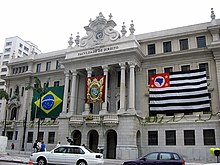
São Paulo is home to numerous important educational institutions, including the University of São Paulo ( Universidade de São Paulo ), founded in 1934 , the largest university in the country, and the second largest and best university in Latin America . There is also the renowned Pontifical Catholic University of São Paulo ( Pontifícia Universidade Católica de São Paulo, opened in 1946) and the Mackenzie University (opened in 1952). A serum institute was founded in the Butantan district in 1901, which is known worldwide for its snake research and the production of vaccines and healing serums . Three museums are attached to the Instituto Butantan, in which, among other things, live snakes can be seen.
The school year in São Paulo and all of Brazil starts in early February and ends in mid-December. The whole month of July is winter holidays. Primary education is free and compulsory. School attendance is compulsory between the ages of seven and fifteen. Many of the students do not finish their training because they have to work beforehand in order to earn a living with the money they have earned. Over ten percent of adults in São Paulo can neither read nor write. Evening schools for the working children and correspondence courses on radio and television have made some successes in literacy.
Education is provided through public as well as private institutions. They are divided into the areas of pre-school and elementary school, secondary school (middle and high school) and the university (with the possibility of courses for postgraduates ). Due to the high number of applicants for a university place, both public and private universities require an entrance examination (“vestibular”). After successfully completing the course, the graduate is awarded the academic degree of a Bachelor's degree . Many educational institutions offer courses in the mornings, afternoons, and evenings. This allows students to work either part-time or full-time. There are currently more than 80 colleges in São Paulo that are recognized by the MEC (Ministry of Education).
sons and daughters of the town
São Paulo is the birthplace of numerous prominent personalities.
literature
- Jürg Müller: Brazil. Klett, Stuttgart 1984, ISBN 3-12-928881-3 .
- Rainer Wehrhahn: São Paulo. Environmental problems of a megacity. In: Geographical Rundschau. Braunschweig 46.1994,6, ISSN 0016-7460 , pp. 359-366.
- Dietrich Briesemeister, Gerd Kohlhepp , Ray-Güde Mertin, Hartmut Sangmeister , Achim Schrader (eds.): Brazil today. Vervuert, Frankfurt am Main 1994, ISBN 3-89354-553-0 .
- Rafael Sevilla, Darcy Ribeiro (Ed.): Brazil - Land of the Future? Horlemann, Bad Honnef 1995, ISBN 3-89502-031-1 .
- Reinhardt W. Wagner: Germans as substitutes for slaves: migrant workers from Germany in the Brazilian province of São Paulo 1847–1914. Vervuert 1995, ISBN 3-89354-155-1 .
- Paula dos Santos: Urban planning from below. The land occupation of Filhos da Terra in São Paulo. Technical University, Berlin 1999, ISBN 3-7983-1799-2 .
- Florian Dünckmann: Coffee in Brazil. In: Geographical Rundschau . Braunschweig 54.2002,11, ISSN 0016-7460 , pp. 36-42.
- Elisabeth Blum, Peter Neitzke : FavelaMetropolis. Reports and projects from Rio de Janeiro and São Paulo. Birkhäuser, Basel / Boston / Berlin 2004, ISBN 3-7643-7063-7 .
- Michael Roschmann: The development of the São Paulo banking center from 1930 to 1988. Tectum, Marburg 2004, ISBN 3-8288-8663-9 .
- Ronald Grätz (Ed.): MINHASP. My São Paulo (= Edition Esefeld & Traub. Volume 9). Edited by Ronald Grätz . Texts by various authors, photos by Iatã Cannabrava and Britta Radike. edition esefeld & traub, Stuttgart 2013, ISBN 978-3-9809887-9-7 (German, English, Portuguese).
- Manfred von Conta, photos: Timm Rautert: São Paulo: Mammon and Macumba . In: Geo-Magazin. Hamburg 1979,5, ISSN 0342-8311 , p. 8–34 (informative experience report: "The urban giant is bursting at the seams. Every year its population grows by three quarters of a million. A chaotic construction boom with a lack of infrastructure and rampant crime overwhelm the authorities. ").
Web links
- City Prefecture website (Portuguese)
- Câmara Municipal website (Portuguese)
- São Paulo Convention & Visitors Bureau (English, Spanish, Portuguese)
- Goethe Institute São Paulo
- Search for São Paulo in the SPK digital portal of the Prussian Cultural Heritage Foundation
- Link catalog on São Paulo at curlie.org (formerly DMOZ )
Individual evidence
- ↑ WEBWRITER: Non Ducor, Duco. Brasão & Divisa da Cidade de São Paulo ( Memento from January 1, 2013 in the web archive archive.today ). In: jor.br, accessed January 12, 2017 (Portuguese).
- ↑ a b c d IBGE : São Paulo - Panorama. In: cidades.ibge.gov.br. July 1, 2018, accessed August 31, 2019 (Brazilian Portuguese).
- ^ Atlas do Desenvolvimento Humano do Brasil: São Paulo, SP. In: atlasbrasil.org.br, accessed January 12, 2017 (Portuguese).
- ↑ IBGE : Estimativas da população residente no Brasil e unidades da federação com data de referência em 1 ° de julho de 2018. (PDF; 2.6 MB) In: ibge.gov.br. 2018, accessed on February 9, 2020 (Brazilian Portuguese, addition of the individual cities in the metropolitan area).
- ^ Os 18 maiores problemas dos paulistanos. Saúde, desemprego e segurança pública ocupam, respectivamente, os três primeiros lugares. In: administradores.com.br. September 19, 2016, accessed on January 13, 2017 (Portuguese; "The 18 greatest problems of the Paulistanos. Health, unemployment and public safety take the first three places."). - Pauli [s] tanos comemoram vitória e prometem mobilização por outros temas ( Memento from June 20, 2013 in the Internet Archive ). In: estadao.com.br. June 19, 2013. Retrieved January 12, 2017 (Portuguese).
- ↑ EMPLASA: Região Metropolitana de São Paulo - Dados ( Memento of July 6, 2011 in the Internet Archive ).
- ↑ Folha Online: Temperatura em SP é a maior em 12 anos. In: folha.uol.com.br. November 11, 1997. Retrieved January 17, 2017.
- ↑ Brasil Abaixo de Zero: A super onda de frio do inverno de 1955 ( Memento of April 22, 2008 in the Internet Archive ).
- ^ Sao Paulo's water supply in "critical" condition as drought bites. In: theguardian.com. January 17, 2015, accessed January 12, 2017.
- ↑ 5.6%. A treta está apenas começando. ( Memento from January 21, 2015 in the Internet Archive ). In: temaguanacantareira.com. January 21, 2015. Retrieved January 12, 2017 (Portuguese).
- ↑ Paulo Suess : A catequese nos primórdios da cidade de São Paulo: Piratininga revisitada por ocasião dos 450 anos de sua fundação. In: Maria Angela Vilhena, João Décio Passos (ed.): A Igreja de São Paulo. Presença católica na história da cidade. Paulinas, São Paulo 2005, ISBN 85-356-1506-7 , pp. 47-75, here p. 48 (Portuguese).
- ↑ Sampaio Moreira. In: emporis.de. Emporis , accessed August 1, 2018.
- ^ Federal Agency for Civic Education : São Paulo - the engine of the Brazilian economy.
- ↑ City Population: Brazil: Metropolitan Regions. Retrieved January 12, 2017.
- ↑ Oliver Döhne: São Paulo. The first macro metropolis in the southern hemisphere. In: Tópicos. 52 (2013), Issue 1, ISSN 0949-541X , pp. 14–15 ( topicos.de [PDF; 1.9 MB; accessed on January 17, 2017]).
- ^ Atlas do Desenvolvimento do Brasil. Database query January 12, 2017 (Portuguese).
- ↑ World Urbanization Prospects - Population Division - United Nations. Retrieved July 23, 2018 .
- ↑ Radiobrás: ethnic groups in São Paulo ( Memento of 23 August 2004 at the Internet Archive ).
- ↑ Radiobrás: 450 years São Paulo ( Memento of 16 August 2004 at the Internet Archive ).
- ↑ Censo Demográfico e Contagem since População. Religions - 2010 Census.
- ^ Karlheinz Kurt Naumann: São Paulo less dangerous? (No longer available online.) In: brasil-treff.com. February 2, 2008, archived from the original on April 25, 2016 ; accessed on December 16, 2019 .
- ↑ RITLA: Mapa da Violência dos Municipios Brasileiros. (No longer available online.) In: ritla.net. 2006, archived from the original on May 28, 2009 ; Retrieved January 12, 2017 (Portuguese).
- ↑ Julio Jacobo Waiselfisz: Homicídios e Juventude no Brasil (= Mapa da Violencia 2013 ). Secretaria-Geral da Presidência da República, Brasília 2013 ( mapadaviolencia.org.br [PDF; 1.9 MB, accessed on January 17, 2017]).
- ↑ Ralf Hoppe: The violence laboratory. In: Der Spiegel. No. 40/2006; quoted n .: materialien.org, accessed January 12, 2017.
- ↑ Thilo F. Papacek: São Paulo in the vicious circle of revenge. In: Latin America News, No. 384/2006, accessed on December 16, 2019.
- ↑ Estatísticas. 2009/10. (No longer available online.) In: ssp.sp.gov.br. Governo do Estado de São Paulo. Secretaria Da Segurança Pública, archived from the original on January 12, 2011 ; Retrieved August 1, 2018 (Portuguese).
- ↑ Katharina Riehle: Impunidade - the problem of impunity in Brazil (= Konrad-Adenauer-Stiftung Main Department for International Cooperation, Country Office Brazil / Study Center Rio de Janeiro (Ed.): Country Report. Focus Brazil. No. 8). September 2007 ( kas.de [PDF; 158 kB; accessed on December 16, 2019]).
- ↑ Gerhard Dilger: Lula's Workers' Party must fear. In: taz.de. October 5, 2004, accessed January 17, 2017.
- ^ Telebörse.de: Bovespa IPO in Brazil ( Memento from April 22, 2008 in the Internet Archive ).
- ↑ a b São Paulo and the German economy. (No longer available online.) In: sao-paulo.diplo.de. Consulate General of the Federal Republic of Germany, archived from the original on January 2, 2007 ; accessed on December 16, 2019 (published after 2005): "the 'largest' German industrial city in the world"
- ^ Latin Trade: Top 500 Companies in Latin America 2006 ( Memento December 27, 2008 in the Internet Archive ).
- ^ Brazil, São Paulo. Production of engines, axles, cabs, trucks and bus chassis. (No longer available online.) In: scania.com. Archived from the original on July 16, 2011 ; accessed on August 1, 2018 .
- ^ Alan Berube, Jesus Leal Trujillo, Tao Ran, and Joseph Parilla: Global Metro Monitor . In: Brookings . January 22, 2015 ( brookings.edu [accessed July 19, 2018]).
- ↑ INFRAERO: Aero Porto do Estado de São Paulo ( Memento of 21 January 2005 at the Internet Archive ).
- ↑ Top 100 Airports. Survey. (No longer available online.) In: Air Transport News. October 9, 2007; archived from the original on February 8, 2011 ; accessed on August 1, 2018 .
- ↑ Frota de SP chegará neste mês a 7 milhões de veículos. In: Estadão.com.br. March 3, 2011, Retrieved March 12, 2011 (Portuguese).
- ↑ Ricardo Rose: Air pollution in São Paulo . In: Brasil-Post . Semanário brasileiro em língua alemã. Bridge to German speakers around the world. No. 2937 . Ed. Brasil-Post, July 20, 2007, ZDB -ID 736042-3 , p. 5 ( archive.org [PDF; 747 kB ; accessed on August 1, 2018] Memento from November 16, 2011 of the scan of the University of Münster in the Internet Archive ).
- ↑ Rodoanel Norte -Dados do Projeto. In: gov.br. Dersa, accessed August 15, 2020 .
- ↑ Operação Horário de Pico no Município: CET - Companhia de Engenharia de Tráfego - São Paulo, SP, Brasil ( Memento of December 23, 2005 in the Internet Archive ).
- ^ Sonja Ernst: São Paulo - engine of the Brazilian economy. Federal Agency for Civic Education, October 19, 2006.
- ^ Railways in São Paulo (Brazil). (No longer available online.) In: standseilbahnen.de. Archived from the original on January 8, 2009 ; accessed on August 1, 2018 (data also on history).
- ^ Metrô São Paulo: Official website. Companhia do Metropolitano de São Paulo - Metrô, accessed December 16, 2019.
- ^ Officials tour Brazil's first monorail. (No longer available online.) In: globalrailnews.com. October 31, 2013, archived from the original on November 6, 2013 ; accessed on December 16, 2019 .
- ^ David Evan Harris: São Paulo: A City Without Ads . In: Adbusters . Journal of the Mental Environment. No. 73 . Adbusters Media Foundation , September 2007, ZDB -ID 2013264-5 (English, archive.org [accessed on August 1, 2018] Memento of February 8, 2008 in the Internet Archive ).
- ^ Elizabeth Gibney: The World Universities Ranking 2011–2012. In: timeshighereducation.com, accessed December 16, 2019.
- ↑ Ser Universitário: Faculdades reconhecidas pelo MEC. In: seruniversitario.com.br, accessed on June 23, 2019.





